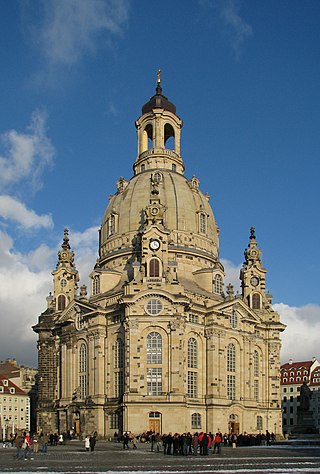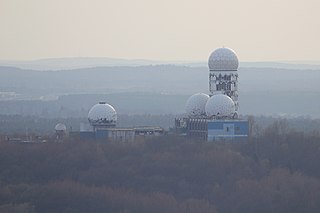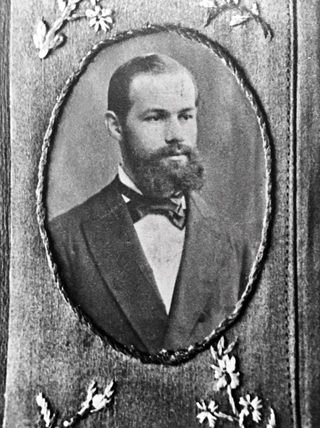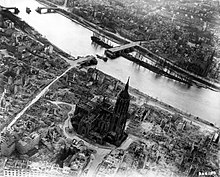
The Frauenkirche is a Lutheran church in Dresden, the capital of the German state of Saxony. Destroyed during the Allied firebombing of Dresden towards the end of World War II, the church was reconstructed between 1994 and 2005.

The Reichstag, a historic legislative government building on Platz der Republik in Berlin, is the seat of the German Bundestag. It is also the meeting place of the Federal Convention, which elects the President of Germany.

Teufelsberg is a non-natural hill in Berlin, Germany, in the Grunewald locality of former West Berlin. It rises about 80 metres (260 ft) above the surrounding Teltow plateau and 120.1 metres (394 ft) above the sea level, in the north of Berlin's Grunewald Forest. It was named after the Teufelssee in its southerly vicinity. The hill is made of debris and rubble, and covers an unfinished Nazi military-technical college. During the Cold War, there was a U.S. listening station on the hill, Field Station Berlin. The site of the former field station is now fenced off and is currently being managed by an organisation which charges 10 euros for public access.

Alte Oper is a concert hall in Frankfurt am Main, Hesse, Germany. It is located in the inner city, Innenstadt, within the banking district Bankenviertel. Today's Alte Oper was built in 1880 as the city's opera house, which was destroyed by bombs in 1944. It was rebuilt in the 1970s as a concert hall with a large hall and smaller venues, opened in 1981. The square in front of the building is still known as Opernplatz.

The Altstadt is a quarter of Frankfurt am Main, Germany. It is part of the Ortsbezirk Innenstadt I and is located on the northern Main river bank. It is completely surrounded by the Innenstadt district, Frankfurt's present-day city centre. On the opposite side of the Main is the district of Sachsenhausen.

The city of Frankfurt am Main started on a hill at a ford in the Main River. The city developed into a financial centre, nicknamed the smallest metropolis in the world.

Skyper is a building complex in the Bahnhofsviertel district of Frankfurt, Germany. The tallest of the three buildings is a 38-storey, 154 m (505 ft) skyscraper. Its quarter-circular silhouette is a distinctive part of the Frankfurt cityscape.

Concrete recycling is the use of rubble from demolished concrete structures. Recycling is cheaper and more ecological than trucking rubble to a landfill. Crushed rubble can be used for road gravel, revetments, retaining walls, landscaping gravel, or raw material for new concrete. Large pieces can be used as bricks or slabs, or incorporated with new concrete into structures, a material called urbanite.

Frankfurt (Main) Hauptbahnhof, also called Frankfurt Central Station and Frankfurt Main Station, is the busiest train station in the German state of Hesse. Due to its location near the middle of Germany and usage as a transport hub for long and short distance travelling, Deutsche Bahn refers to it as the most important station in Germany.

The Hindenburgdamm or Hindenburg Dam is an 11 km long causeway joining the North Frisian island of Sylt to mainland Schleswig-Holstein. Its coordinates are 54°53′N8°33′E. It was opened on 1 June 1927 and is exclusively a railway corridor. The companies that built the Hindenburgdamm, a job that took four years, were Philipp Holzmann AG of Frankfurt, working from the mainland, and Peter Fix Söhne of Duisburg working from Sylt. A train trip along the causeway takes about 10 minutes, and the time between the auto terminals at Niebüll on the mainland and Westerland on Sylt is about 30 minutes. The Hindenburgdamm is part of the railway line known as the Marschbahn, which is double-tracked along much of the route, although there as yet exists a single-tracked stretch. On the causeway is a signal box. The rail line is not electrified making the use of diesel locomotives necessary. Trains coming from origins further south like Hamburg change from an electric locomotive to a diesel locomotive at Itzehoe.

GEA Group AG is a German corporation, mostly active in the food and beverages sector, headquartered in Düsseldorf, Germany. The company is listed on the MDAX.

Schuttberg is a German term for a mound made of rubble or out of a rubbish heap.

Philipp Holzmann AG was a German construction company based in Frankfurt am Main.

Trümmerfrau were women who, in the aftermath of World War II, helped clear and reconstruct the bombed cities of Germany and Austria. Hundreds of cities had suffered significant bombing and firestorm damage through aerial attacks and ground war, so with many men dead or prisoners of war, this monumental task fell to a large degree on women.

The Birkenkopf is a prominent hill in Stuttgart, Germany. At an elevation of 511m, is almost 260m higher than city centre. It is in part a Schuttberg, an artificial hill built from the ruins and rubble from World War II.
The CeramTec Group is a developer and manufacturer of products and components made of technical ceramics. The products are marketed through its own sales companies, among others. They are primarily used in medical technology, automotive engineering, electronics, equipment and mechanical engineering, environmental and energy technology, toolmaking, the chemical industry and the semiconductor industry. The company is headquartered in Plochingen in Baden-Württemberg, Germany.

Demolition waste is waste debris from destruction of buildings, roads, bridges, or other structures. Debris varies in composition, but the major components, by weight, in the US include concrete, wood products, asphalt shingles, brick and clay tile, steel, and drywall. There is the potential to recycle many elements of demolition waste.

The Chernobyl Nuclear Power Plant sarcophagus or Shelter Structure is a massive steel and concrete structure covering the nuclear reactor number 4 building of the Chernobyl Nuclear Power Plant. The sarcophagus resides inside the New Safe Confinement structure. The New Safe Confinement is designed to protect the environment while the sarcophagus undergoes demolition and the nuclear cleanup continues. The sarcophagus was designed to limit radioactive contamination of the environment following the 1986 Chernobyl disaster, by encasing the most dangerous area and protecting it from climate exposure. It is located within a large restricted area known as the Chernobyl Exclusion Zone.

Fritz Schloß Park is a park in Berlin in the district of Moabit, located in the borough of Mitte.

Zachary Hochschild was a German businessman, metal trader, and co-founder of Metallgesellschaft AG.






















